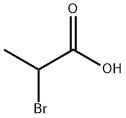Chemical Properties
white to pale yellow or orange crystalline. soluble in water, alcohol, ether, chloroform, benzene. Hydrolysis in alkaline solution generates hydroxypropionic acid. Corrosive. for organic synthesis.
Uses
3-Bromopropionic acid used as quaternization agent in amperometric biosensors.
Application
3-Bromopropionic acid is a widely used chemical intermediate. It can be used as a starting material to synthesize derivatives such as esters, acid halides and amides; the active group bromine can undergo a series of reactions, and is mainly used in the fields of pesticides and medicines. Such as the pesticides diflufenacil, furalax and so on.
Preparation
3-Bromopropionic acid is prepared by reacting acrylonitrile with hydrogen bromide to obtain bromopropionitrile and then hydrolyzing it. Add acrylonitrile to boiling hydrobromic acid, reflux at 130°C for 6 hours, extract the solid obtained by filtration with ethanol, and obtain the crude product after recovering ethanol by distillation under reduced pressure. By heating 2-cyanoethanol and 40% hydrobromic acid to reflux for 2h, 3-bromopropionic acid can also be produced with a yield of over 80%.
Synthesis Reference(s)
Journal of the American Chemical Society, 71, p. 2807, 1949
DOI: 10.1021/ja01176a061Organic Syntheses, Coll. Vol. 1, p. 131, 1941
Safety Profile
Moderately toxic by
intraperitoneal route. Questionable
carcinogen with experimental tumorigenic
data. Mutation data reported. When heated
to decomposition it emits toxic fumes of
Br-. See also BROMIDES.
Purification Methods
The acid crystallises as plates from CCl4. It is soluble in organic solvents and H2O. Its methyl ester has b 65o/18mm and 80o/27mm. The S-benzylisothiouronium salt has m 136o. [Kendall & McKenzie Org Synth Coll Vol I 131 1941, Beilstein 2 IV 764.]





